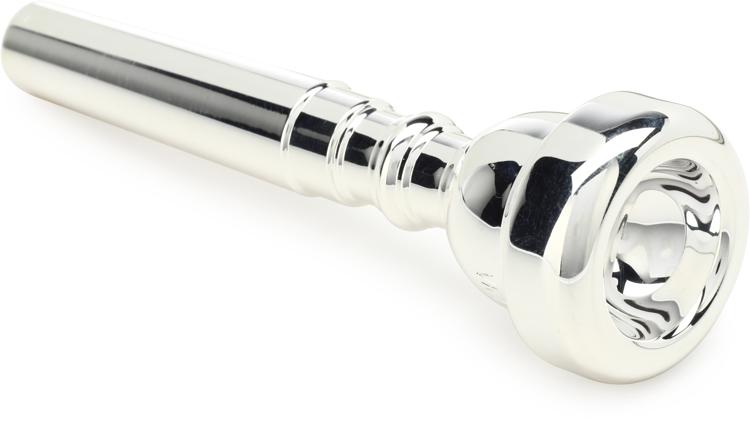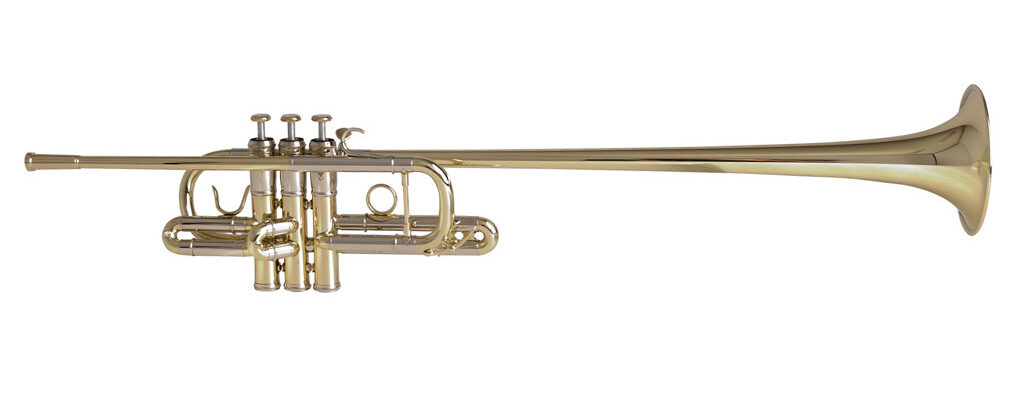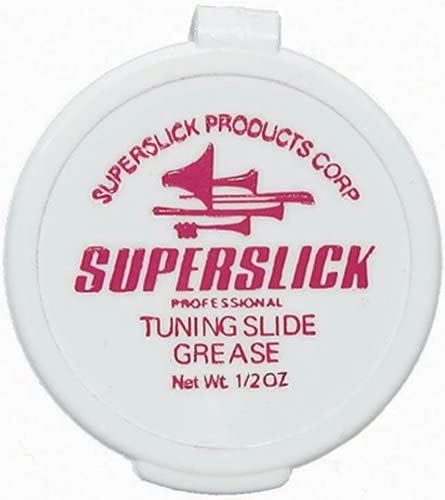- Euphonium vs Baritone Compared - September 5, 2022
- How to Find the Best Contra Alto Clarinet - August 20, 2022
- Mellophone vs Trumpet Compared - August 6, 2022
Whether you’re shopping for a new horn or simply thinking about taking up the trumpet, it’s good to do your research first. Advertisements presume that you know the difference between a spit valve and a piston valve. And the better you understand how a trumpet works, the better you will appreciate just what an amazing instrument the trumpet is.
You already have a trumpet? Great! This article will give you a brief rundown on the physics and engineering that make your trumpet produce sound. I’ve also provided some maintenance advice, to ensure that your instrument plays its best for years to come. Repairing a neglected instrument can be expensive. When you finish this article, you’ll know how to avoid those costly mistakes.
Mouthpiece
Although saxophones are made of brass, they are not brass instruments. A saxophone produces its sound with a reed, like other woodwinds. (Nor, as we will see later, are all brass instruments made of brass. But all brass instruments use a cup-shaped mouthpiece into which musicians buzz their lips.
The vibration of the musician’s lips resonates through the air column in the brass instrument and the instrument’s body. This produces the characteristic sound of brass instruments and is the underlying mechanism behind the sound of every brass instrument from piccolo trumpet to contrabass tuba.
Your trumpet’s mouthpiece is detachable. This lets you use different mouthpieces and allows you to put your instrument in a smaller case. You can even play the mouthpiece by itself to exercise your embouchure (lip vibration) and strengthen your lips. It also lets you choose a mouthpiece that best suits your playing style and produces the tone quality you are looking for.
When you are done playing, clean your mouthpiece with a mouthpiece brush in warm water with dish detergent to remove deposits. If you ever share mouthpieces with another musician, make sure they are thoroughly disinfected before and after playing to avoid the spread of diseases.
Recommendations
If you are not entirely satisfied with your current trumpet mouthpiece, you should check out Bach mouthpieces. Before he began designing his world-famous Stradivarius trumpets, Vincent Bach was a mouthpiece maker. Today Bach mouthpieces remain highly sought after even by performers and the Bach 3C (pictured above) is one of their most popular models with professional trumpeters, though many beginning trumpeters find the Bach 7C more comfortable.
Leadpipe
The leadpipe (also called a mouthpipe) is the tube into which you place your mouthpiece. While mouthpieces are easy to swap out, most leadpipes are permanently affixed to the trumpet and can only be changed by an instrument repairperson. But some trumpets have detachable leadpipes that allow you to select leadpipes with different tonal and playing characteristics.
Most trumpets are built so that the leadpipe goes into the tuning slide. Reverse leadpipes are wider in diameter, so they have slightly less resistance. Many trumpet players believe they provide better intonation and control.
When you insert your mouthpiece in the leadpipe, be gentle. If you put your mouthpiece into position with too much force, you can end up with a stuck mouthpiece. If your mouthpiece is stuck, don’t try forcing it out with pliers. An instrument repair specialist can get the mouthpiece loose for much less than it will cost to replace a damaged leadpipe.
Recommendation
If you want to breathe some new life into your old trumpet, talk to Charlie at Charlie’s Brass Works. Charlie Melk can design and build a new leadpipe for your vintage instrument no matter the make or model. Melk also does complete restorations, so if you’ve just inherited your grandfather’s dusty old Martin Committee Charlie’s Brass Works may be able to bring the instrument back to its glory days.
Tubing
Your trumpet, like every brass instrument, works according to the laws of acoustical physics. As the buzzing from your lips travels through the instrument, it is amplified by the pipe that holds the air column in place. The tubing length determines the instrument’s fundamental pitch. The longer the tubing, the bigger the column of air and the lower its fundamental note.
Your B♭ trumpet has 1.48 meters (4’10”) of tubing. Because that would make for a very long straight horn, the trumpet’s tubing is wrapped into a more compact and manageable shape. A herald trumpet (pictured above) has a looser wrap that extends the bell further out. These are most often used for ceremonial or stage settings.
A few instrument makers have built trumpets using gold or silver, and there are even some carbon fiber trumpets on the market. But the overwhelming majority of trumpets from student to professional level, are made using brass.
Every few weeks you should run a pipe cleaner or cleaning snake through your instrument’s tubing to get rid of any unwanted grime. When dirt is left undisturbed in your instrument, it begins to interact with the metal. In time this dirt can lead to corrosion or “red rot,” an irreparable breakdown of the brass alloy.
Recommendation
Yamaha’s YAC1077P Trumpet Cleaner is designed and sold by one of the world’s largest and most prestigious instrument makers. (Check out my review of the best Yamaha trumpet options). The YAC1077P will keep your instrument clean, dry, and in prime playing condition, and is my recommendation for the best trumpet cleaning brush.
Valves
Your trumpet has three valves that open different lengths of tubing. The first valve lowers the pitch by a whole tone, the second by a semitone, and the third by a minor third, or a tone + a semitone. These valves allow trumpeters to play a complete chromatic scale (all the white keys and black keys in a piano octave).
The three valves give you seven different finger positions you can use. With those combinations, a competent trumpet player can play every note from the E below middle C to the C above high C (E3-C6, written in transposed trumpet music as F#3-D6). And skilled trumpeters with strong lip and breath control can go beyond this into the altissimo range. In the recording of William Russo’s Titan Symphony, Maynard Ferguson hits and sustains a D7, over an octave above the trumpet’s normal top note.
The valves in student trumpets are usually made with nickel silver with nickel plating. While these valves are less expensive to produce, the nickel plating can be prone to flaking. The valves in most professional trumpets are made with monel (a wear and corrosion-resistant copper/nickel alloy) or stainless steel.
Trumpets use piston valves that open the pipe when they are pressed down. In Eastern Europe and in 19th century orchestral works, trumpets more often use rotary valves. A rotary trumpet is held sideways like a big sandwich. When the musician presses the rotary valve paddles, the valve rotates to open the pipe.
To keep your trumpet playing smoothly, clean your valves regularly, then lubricate them with a few drops of valve piston oil. A weekly cleaning will prevent wear on the pistons and casings and extend the life of your instrument.
To clean your valves:
- Remove each valve slide and wipe it clean with a paper towel or soft cleaning cloth.
- Unscrew the bottom valve caps and clean them with a tissue or paper towel.
- Unscrew the top valve caps and remove the valve casings. Be sure to note the number of each valve and which way the valve is facing.
- Fill a glass partly full with lukewarm water and dish detergent. Soak the valve casings in the glass, but be careful not to let the felt at the top get wet, as you will have to replace it if this happens.
- After you have let the valve casings soak for a few minutes, clean them thoroughly with a brush. You may be unpleasantly surprised at the amount of gunk you remove.
- Dry the valve casings thoroughly, then oil them with a few drops of valve oil and reassemble them.
Recommendation
While there are many different brands of valve oil on the market, trumpet professionals agree that Blue Magic Valve Oil is one of the best instrument oils available. Blue Magic is formulated to be thin enough to coat valves completely, but thick enough to keep things lubricated through long sessions.
If you notice a valve is sticking even after you oil it, see an instrument technician. A dent too tiny to see can cause friction when you play.
Tuning Slides
Trumpets are well-designed machines, but they can be finicky. Heat, humidity, and elevation can all have an influence on your instrument’s pitch and leave you blowing sour notes. The tuning slide helps you stay on key. If you are blowing a little sharp, pull the slide out to bring the tone down. If you are blowing flat, push it in and you raise the tone.
Each valve also has a tuning slide that you can adjust by pulling a finger loop. Whenever you play a note with the first and third valve depressed, or with all three valves depressed, it will tend to be sharp. Many higher notes will tend toward being flat. The valve slides can help you adjust that as you play. While you can correct notes using your embouchure and breathing, the tuning slides are a much easier and more effective way of staying in tune.
Keeping your tuning slide lubricated with slide grease will ensure smooth movement when you need to make adjustments. Keep your valve slides lubricated with valve oil and you will be able to rely on them for those notes that will otherwise be off-key.
Recommendation
For keeping your tuning slide lubricated, I recommend Superslick Tuning Slide Grease. Superslick is slippery enough to keep your slide moving smoothly as you get your instrument in tune. But it is also thick enough to create an airtight seal, ensuring that you get the best possible feedback and tone from your instrument as you play.
Spit Valves
Your trumpet has a small lever that instrument makers call a water key and everyone else calls a spit valve. As you blow through your instrument, moisture condenses on the inside. If too much moisture builds up, you can get an unpleasant bubbling and gurgling while you play as the spittle clogs your tubes. And if the spittle stays in your instrument too long, it can lead to corrosion.
A trumpet’s spit valve looks like the lever key on a clarinet, but instead of a pad it is fitted with a cork. A spring holds this cork tightly in place during play so there are no air leaks. The valve only opens when the musician presses the lever. If you have recently noticed intonation problems with your trumpet, check to see that your spit valve is tightly in place. If there is a problem, replacing the cork is a simple repair that involves gluing a properly sized pad to the valve.
Recommendation
Spit valve corks are inexpensive and readily available on Amazon and elsewhere. You can get a dozen 9mm x 4mm valve corks from Amazon for under $10. Keeping corks in your instrument case will ensure you are always ready to fix a leaky spit valve wherever you may discover it.
Bell
The trumpet’s famously loud and forward sound is due to the instrument’s bell. The trumpet bell’s wide flare couples with the air to amplify and project the sound. And as the sound resonates through the bell, the brass provides additional harmonics that give the trumpet its distinctive sound.
Because the bell plays such an important acoustic role, tiny changes in the bell can make a huge difference in the final sound. A thinner bell will provide a brighter, more piercing sound, while a thicker bell gives a richer and darker tone. Smaller bells with a narrower throat have a more forward sound while larger bells with a wider throat have a mellower sound.
Dizzy Gillespie’s famous “crooked” trumpet was born when somebody fell on his trumpet and bent the bell. Dizzy played a few notes, liked the sound, and from then on Dizzy played his trumpets with the bell bent at a 45° angle. If somebody falls on your trumpet, you may not be as fortunate as Dizzy. Bells are naturally fragile and easily dented.
Recommendation
Because you want to keep your bell looking as bright and shiny as it sounds, you’re going to need a polishing cloth. Wiping down your horn after every session will remove fingerprints, water spots, and skin oils that can leave your horn looking less than its best. The Giardinelli Microfiber Polishing Cloth is designed to keep brass instruments looking their shiniest.
Case
Technically speaking, a case is not an integral part of your trumpet. You can’t play a trumpet with a missing valve or tuning slide, but you can play a trumpet with a missing case. But, as you may have gathered from the information above, trumpets are finely designed instruments. One little fall or impact can leave you with a costly repair bill, or in the worst cases, with an expensive brass paperweight.
A good sturdy case that will protect your trumpet from the rigors of travel and performing is an investment in your musical career. A decent trumpet case can be had for $100 or less, but you may want to spend more if you do a lot of touring or if you own an irreplaceable heirloom horn. If you’ve been carrying your trumpet around in the battered old case it came in, you may be putting your instrument at risk. A small investment now can save you a lot of trouble later.
Recommendations
The Protec PRO PAC Trumpet Case (pictured above) will be the last instrument case most trumpet players need. With trumpet cases, greater protection generally means a bigger and heavier case. The PRO PAC offers very good protection without backbreaking weight or overwhelming bulk. The PRO PAC is sized to fit almost any trumpet, and is roomy enough for your accessories too.
FAQ
Answer: The fingerings are the same for a B♭ trumpet and a baritone horn or euphonium, though the instrument will sound an octave lower. And most euphonium music is written in treble clef, so you won’t have to learn the bass clef. You can also use trumpet fingerings to play valve trombone, but valve trombone music is typically written in bass clef and at concert pitch. You will need to learn a new clef and transpose the music up a step.
While the mouthpieces have different shapes and sizes, the lip-blowing technique is very similar for all brass instruments from piccolo trumpets to contrabass trombones.
Answer: A trumpet has three valves that let you play an entire chromatic scale on the instrument. A bugle has no valves and is a single continuous spiraling tube. Bugles can only play in a particular key and are typically pitched in C, F, G, or B♭. Bugles are traditionally used for military drills and battle calls. The extra valves on a trumpet make the instrument heavier and more prone to sticking and damage than the simpler bugle.
Answer: B♭ trumpets are the trumpet most frequently used in jazz and popular music, and most of the trumpets you will see for sale are in B♭. But B♭ trumpets are not the only trumpets available.
Many orchestral pieces are written for the C trumpet, which is pitched a tone above the B♭ trumpet. For higher parts, some trumpet players rely on an E♭ trumpet that is pitched a full fifth above the standard trumpet. (Imagine the difference between a B♭ tenor saxophone and an E♭ alto sax and you’ll get an idea of the difference. And some Romantic pieces call for a trumpet in low F that is pitched a full fifth lower than a standard B♭ trumpet.
Conclusion
Now you know a little more about trumpet parts and how a trumpet works. Regular trumpet maintenance takes some time, but it will save you a lot of money and can help you keep your instrument in top shape.
That being said, a little knowledge is a dangerous thing. If you have a serious problem with your instrument, take it to a repair shop rather than trying to fix it yourself. Instrument repair professionals have the tools and knowledge to fix many problems that are beyond your capabilities. Regular maintenance combined with a regular annual checkup at the music store will ensure your instrument performs its best through many years of happy playing.
Looking for more interesting readings? Check out:


















